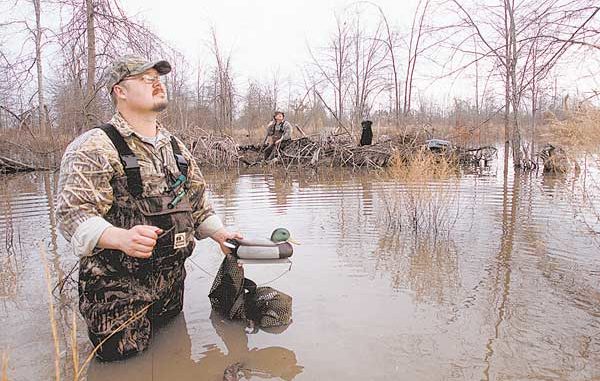
The Little Pee Dee River offers waterfowlers untapped public hunting opportunities.
Not every hunter has the time or means to travel to places where web-footed birds blacken the sky. Most hunters can’t spend the price of a good duck boat for a single year’s shared hunting lease where fields of grain are flooded to attract ducks by the dozen.
The majority of South Carolina duck hunters are like Lee Satterfield of Floyd, who tries to get in a couple of guided hunts each year but puts in most of his hunting time on close-to-home waters that he also fishes during the summer.
“I like hunting along the Little Pee Dee River,” Satterfield said. “I’ve hunted the entire length of the river with a 1-man plywood boat and a skiff and had good luck hunting from both of them.”
Satterfield owns Palmetto Pump Services in Myrtle Beach, where he designs and installs large pumping systems for golf courses, municipalities and private waterfowl impoundments — he sometimes gets an invitation to hunt the cornfields his pumps flood. Those sporadic outings are often fantastic in terms of quality and quantity of birds, but along the river, the challenge, beauty and solitude are at least as alluring as the ducks.
“Wood ducks are by far the most common ducks on the Little Pee Dee River,” he said, “but I kill a few green-winged teal and mallards, and I’ve also seen Canada geese. I’ve also shot ring-necks and hooded mergansers, especially in the small lakes and wide creeks in the Little Pee Dee River Heritage Preserve.”
The Lumber River adds its water to the Little Pee Dee near Nichols. The increased flow makes the river more accessible to outdoorsmen from that point until it enters the Great Pee Dee River near Bucksport. This 40-mile stretch is one of the wildest reaches in the state. The water level changes constantly, and while the ups and downs can be a major headache for those who try to anticipate the river’s mood swings, it also keeps timid hunters from ever giving it a try.
“I don’t like to hunt when the water is really high water, because it puts the ducks back in the swamp,” Satterfield said. “A wood duck doesn’t need more than six inches of water to get around and feed, so he heads for the flooded oak stands where you can’t go. On really low-water conditions, you can’t navigate up and down the river, so there’s no need to even go. The best time to hunt is when the river is in a normal flow stage, within its banks, with enough water depth to run it safely in a small motor.”
Satterfield scouts before he attempts a hunt, launching his 15-foot Sea Ark and drifting along late in the afternoon or at first light. Wood ducks fly to and from their roosts early and late, and Satterfield watches and listens to them, discovering their flight patterns.
“I have a homemade, scissors-style blind made of conduit covered with camouflage netting on my 15-foot boat,” he said. “I find a point where the ducks are flying and try to set up at that spot well before dawn. Scouting tells you two things. You know where the ducks are flying and where to set up in the dark.”
An early arrival is imperative to the fastest shooting. Satterfield said he and his two sons have taken a 3-man limit of nine wood ducks in the first 15 minutes of daylight.
“The wood duck activity really slows down after dawn,” he said, “but the wood duck hunting is mostly pass shooting, so I always toss out a few decoys to attract other species. I never set out more than a dozen decoys. I set mallard and wood duck decoys using the same rigging I use for the coast. Each decoy has 15 feet of line wrapped around a lead ring anchor that fits around the decoy’s head. The line is wrapped around the anchors, which have little ears to hold the line. When you toss the anchor over, line unwinds until the anchor hits the bottom.”
Downsides to this type of anchor arrangement are that the anchor flip-flops as line is retrieved, forcing the hunter to rewind all of the line. The anchor can also hang up in the woody tangles along the bottom.
“Occasionally, the anchor hangs up, and I tie the line to the boat cleat to break it off,” Satterfield said. “But the ring anchors hold well in the current, which can be very strong.”
Satterfield also hunts in the Little Pee Dee River Heritage Preserve WMA, which consists of several tracts of river swamp and upland along either side of the river in Horry and Marion counties.
“There are creeks, sloughs and lakes inside the heritage preserve,” he said. “The hunting can be hit or miss, but if you pick the right spot on the right day, you can have a great hunt.”
The WMA is open for duck hunting from legal shooting light until noon on Wednesdays during federal waterfowl hunting seasons. Satterfield said the limited hunting days offers an excellent opportunity.
“I’ve hunted some of the lakes and had them all to myself because others can’t hunt on Wednesday morning,” he said. “But all of the lakes can have difficult access under certain conditions. They are all accessible from the river during flood conditions, if you can find them going through the trees in the dark. On low or normal water conditions, you can drive to them with a 4-wheel drive or at least get close enough to drag a kayak or small boat to the water’s edge.”
Satterfield hunts Marsh Lake, which is on the Little Pee Dee River tract. In addition, another set of oxbows are located along Cedar Creek.
“There are some deep potholes in the roads leading to the lakes,” he said. “Even if you have a 4-wheel drive vehicle, it pays to keep your waders on so you can get out and walk the potholes to find the best crossings. The potholes can get deeply rutted by the time duck hunting season arrives.”
Other oxbow lakes within the WMA are Jack Lake, Sandy Isle Lake and Hog Lake, all within the Dargan Tract — but many other beaver ponds, potholes and creeks attract and hold waterfowl.
Satterfield has better success using decoys on open ponds than with pass shooting. The ducks are attracted to the open water, spot the decoys and attempt to land among them.
“I cover the boat with a camouflage net,” he said. “I might hunt out of the boat, but if I can, I stand on the bottom or on the ground. Standing allows me to turn easier. If you hunt out of the boat, your shooting zone is limited.”
Satterfield shoots a full-choked12-gauge shotgun loaded with No. 3 steel shot.
“I shoot steel because it’s the most inexpensive ammunition,” he said. “If I can, I buy as much as I can afford whenever I find it on sale.”
The roads that provide vehicle access were built with soil excavated from the sandy ridges interspersed with the swamps. The resulting borrow pits become shallow lakes, which grow plants that attract puddle ducks like teal and mallards when they become flooded.
“If I spook some ducks off one of the potholes, I make a mental note of the place,” he said. “The advantage of hunting the borrow pits is that you don’t need a boat. You can wade out to set the decoys and pick up downed ducks. You find a tree to break up your outline, and put on a face net, and the only blind you need is your hat.”
Basil Watts of Southport, N.C., who does more duck hunting in South Carolina than his home state, often hunts with Satterfield.
“I’ve hunted ducks with Lee,” he said, “but I’d rather hunt later in the day. I know wood ducks fly better at first light, but I’ve found that no matter what time of day you hunt, you can fill out a limit of wood ducks. Other ducks species seem to fly better up in the day than they do at first light.”
Watts hunts from a boat blind, but he also likes to use a skiff and paddle along the creeks.
“Jump-shooting ducks is an exciting way to hunt,” he said. “Sometimes a decoy hunt is the most boring hunt in the world, but there’s nothing boring about coming around a bend and jumping up a flock or a single duck. You’d better be quick on the draw or all you’re going to hit is air.”

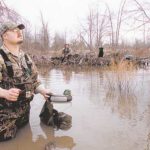

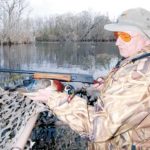
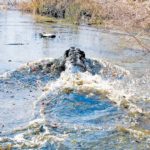
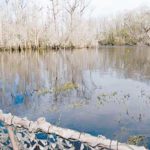
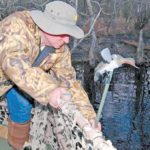



Be the first to comment